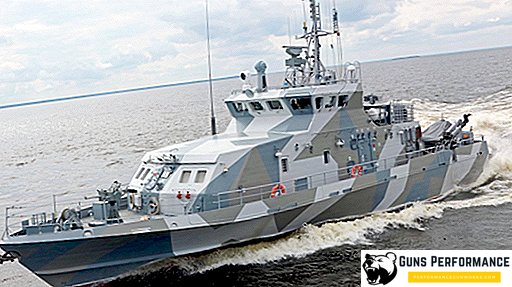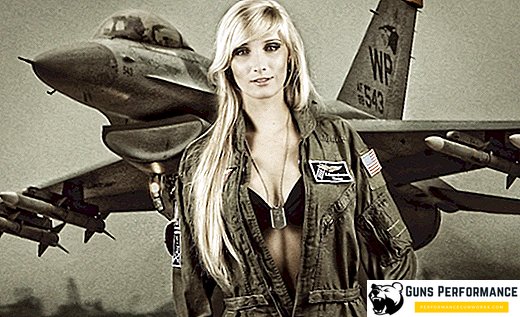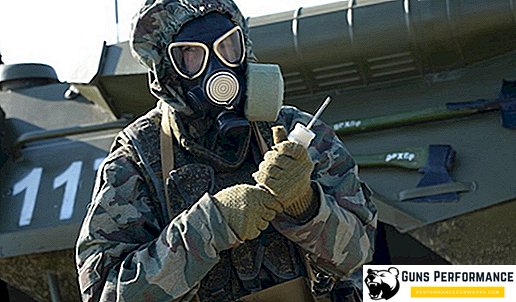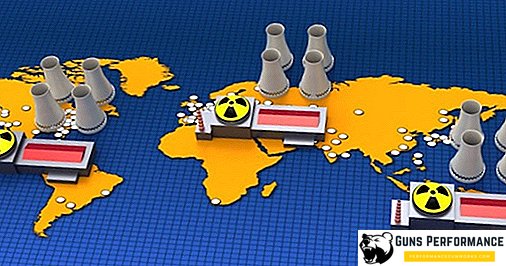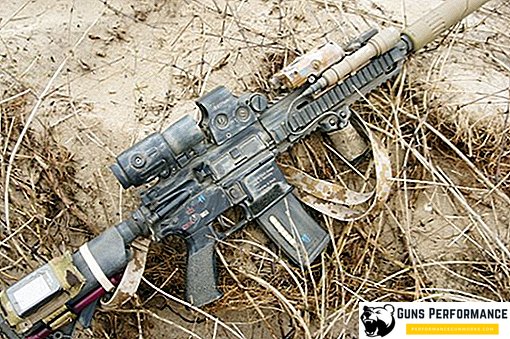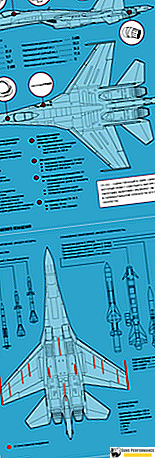
Su-35C (C = serial) is a nearly fifth generation multi-purpose fighter (the so-called 4 ++ generation). Until the desired 5th, there is not enough stealth: ESR = 0.7m2 (for the F-22, the effective dispersion area = 0.1 m2, and in the frontal projection, even 0.001 m2).
The difference between the Su-35 and its foreign counterparts is an engine with a thrust vector that is deflected horizontally and vertically. This means that the Su-35 can steer the engine in any direction and quickly change direction, as well as:
- “get on the tail” (“Pugachev's cobra”) to drastically slow down and deceive the rocket;
- make a dead loop of small radius ("Frolov Chakra", radius - the length of the aircraft), to go into the tail of the enemy;
- spin horizontally, like a whirligig, almost without losing speed (“pancake”, it’s also a “dry leaf”) to instantly gather information on 360about around.

The real score of the battle SU 35 vs F 22
There was never a real battle, even a training one, for the F-22 Raptor against the Su-35. But there were 2 conditional collisions of fighters, flattering for our aircraft:
- In July 2008, Australia chose which fighters to buy from the United States. At the American base in Hawaii, 20 Su-35 air battles against the F-22 "Raptor" (as well as other efok: F / A-18 and F-35) were modeled. As a result, Australians refused to buy efki: the US fleet won only 1 time. Details are not disclosed, the victory of the Su-35 was explained by super-maneuverability;
- In December 2017, the F-22 Raptor and the Su-35 met in Syria. According to the Russian Ministry of Defense, the F-22 prevented the Su-25 from planning to destroy terrorists, according to American data, that our plane violated their airspace (although where did they get their airspace in Syria?). Su-35 came to the aid of his compatriot, "Raptor" immediately left the zone of visibility.

The opinions of the “Business Insider” and “National Interest” experts agree on the 3 advantages of the Su-35 over their 5th generation fighters (F-22 and F-35):
- super maneuverability;
- electronic warfare systems (EW, in other words - anti-radar and anti-missile) - GPS lock, laser and thermal interference for self-guided missiles;
- combat load (12 air-to-air missiles with a range of 20-300 km), which is launched even at supersonic (which gives additional power).
Defense Industry Daily military expert Bill Svitman also notes supermaneuverability. Air-to-air missiles model where the target will be in 1-2 seconds, and figures like a cobra or a pancake do not fit into the algorithms. The F22 also has no side sensors (side-looking radar). If the target abruptly goes sideways (90about and more), Raptor will also have to change course and lead the missile, otherwise it will lose target designation (it comes from the fighter to the final segment).
Comparison of characteristics of SU 35 and F 22
F-22 "Raptor" relies on stealth and long-range combat: it is faster to detect the enemy (150 km against 90 km) and to launch a missile faster (the range of the most advanced AIM-120D Scorpion is 180 km). Su-35 is good for close combat (dogfight). If he survives the long-range attack (and the chances are quite high) and sees the enemy on the radar, the F22 will have serious problems.
The fundamentally important comparative technical characteristics are in the following table:
| F-22 | Su-35 | |
| 5th generation specifications | ||
| ESR | 0.001-0.1 m2 | 0.7-2 m2 |
| Radar station | AN / APG-77 with active phased array antenna. Detection range: Su-35 - 150 km Air targets with EPR = 1m2 - 225 km | "Irbis" with a passive phased antenna array. Detection range: "Raptor" (targets with EPR = 0.01 m2) - 90 km Air targets with EPR = 3 m2 - 150-400 km |
| Optics in the infrared spectrum | No (will not track the flight of other fighters at night) | OLS-35 (optical-location system) with heat and television channels |
| Target infrared detection and tracking system | not | IRST (passive scanning infrared system - does not impersonate, since it does not emit waves) is built into the OLS-35, the range is 80 km, 4 targets simultaneously. |
| Rocket launch warning | Yes | Yes |
| Supersonic without afterburner | Yes (cruising speed is 1960 km / h, or Mach 1.82) | Yes (cruising speed - 1350 km / h, or 1.1 Mach) |
| Dimensions and flight characteristics | ||
| Maximum speed at afterburner | 2.25 mach (2410 km / h) | 2.25 mach (2410 km / h) |
| Combat radius | 760 km | 1600 km |
| Ferrying range (without outboard fuel tanks and refueling) | 3220 km | 3600 km |
| Maximum height | 20 km | 20 km |
| The size | 19x14x5 m | 22x15x6 m |
| Weight | Empty - 19.7 tons Take-off - 38 tons Fuel - 8.2 tons | 19 tons empty Takeoff - 34.5 tons Fuel - 11.5 tons |
| Armament | ||
| Maximum air-to-air missiles | 6 inside + 2 outside | 6 inside + 8 outside |
| Combat load | 3.5 t | 8 t |
| Ranged weapons | AIM-120 in various versions with infrared and radar homing, range - 50-180 km | R-27 in various versions with infrared or radar homing, range - 50-110 km K-77M with radar homing, range - 190 km R-37 with radar homing, range - 300 km |
| Melee Weapon | New AIM-9 with a matrix infrared homing head and thrust vector control. Range - 18 km | R-73M with dual-band infrared homing head and aerogasdynamic control. Range - 20 km |
| Aerogun | Drum 20-mm Volcano M612A | 30 mm GSh-30-1 |
| How much and for how much | ||
| the cost | 140 million dollars | 50 million dollars |
| Amount in service (for 2018) | 180+ | 50 |
| Experience of use | Since 2005 | Since 2014 |

F 35 vs SU 35
F-35 "Lightning II" (Lightning) - the 5th generation invisible fighter-bombers in 3 versions:
- ground-based (CTOL) F-35A, exported to NATO allies;
- vertical takeoff and landing (STOVL) F-35B;
- Deck (CV) F-35C.

Modifications differ in size (the deck is the largest, but still smaller than the Su-35) and flight characteristics, but the assignment of all three is to bombard the ground after heavy fighters clear the air (for example, the Raptors F-22). Air-to-air missiles (up to 180 km range) and a 25-mm air cannon in the "Lightning Two" are (in the F-35B and C - in a separate outboard container), but this weapon is not the main one.
F-35 airborne combat will be avoided by all means:
- The concept of “invisible” itself implies long-range combat (the first one saw — the first one sent a rocket)
- The tasks of the bomber is not included to fight with super-maneuverable fighters.
By the number of weapons and speed parameters, it is also not designed for dogfight. Internal suspensions - 4, external - 6, but they greatly reduce stealth (EPR presumably 0.005 m2 *). But the bet is made all the same on invisibility, and not on super-maneuverability or super speed:
- to fly on supersonic (1.2 Mach) without Forsage F-35 can only 150-240 km (according to various sources) - the engine has a small performance;
- cruising speed - 850 km / h;
- the maximum speed is 1.6 Mach (1930 km / h);
- range - 2500 km;
- height - 18 km.

If you compare a bomber with a fighter, all of the above characteristics lose the Su-35. But that "Lightning" is beyond praise - this is the radar AN / APG-81 with an active phased antenna array:
- Review - 360o;
- target detection range with EPR = 1m2 - 250-400 km;
- night navigation;
- All-view passive infrared camera (does not emit waves, but only absorbs, without giving itself away).
With its help, the F-35 will notice the Su-35 in time and orient itself in the situation, remaining invisible. If he has time, he will finish the combat mission and fly away while he is complete. If a rocket is ready, it will get close to 180 km and will try to knock down the enemy, while he will try to increase the distance (all of a sudden the rocket will not reach the target ...). And in any case, rapprochement will be avoided - according to Australian experts, the probability of victory in a battle with the Su-35 is 28%.

Eurofighter typhoon vs SU 35
Eurofighter Typhoon (EF2000) - a good European generation fighter 4+. Like the Su-35, it does not reach the 5th generation due to its high visibility (EPR = 1m2), but it already has an active PAR (phased antenna array).
By the way, AFAR also has the French fighter Rafale. Against the Su-35, he, too, never fought in actual conditions, but India almost bought it instead of our Su-30MKI. Fortunately, the incident ended in our favor.

Externally, the Eurofighter is 6 meters shorter and 4 meters narrower than the Su-35. Differences in dimensions give the difference in mass (11 tons versus 19 tons on the Su-35) and rate of climb (315 m / s vs 280 m / s, respectively). At the same time, the combat load of them is almost identical: 8 tons of the Su35 against the Eurofighter from 7.5 tons. The suspension nodes of the EF-2000 are as many as 13 - 1 more than the Su-35. The maximum (2.25 Mach) and cruising (1.2 - 1.1 Mach) speeds of the fighters are approximately equal, as is the ceiling height (19.8 vs. 20 tons), so that the rockets launched by supersonic will fly with enormous energy .

The target detection range of the Su-35 is slightly higher - 400 km versus 300 km for targets with EPR = 3 m2. Also, the Su-35 has a missile launch warning system. Both fighters control the engines in all directions, but the Su-35 has the maneuverability advantage. The combat radius of the EF-2000 with a full load of air-to-air missiles and 1 PTB is 1,300 km. Su-35 in similar conditions covers 1,800 km.
Eurofighter boasts a rocket "Meteor" (range - 100 km) with active radar guidance. Targeting is possible in the passive mode - from the infrared complex or the radiation source, to fool it is very difficult.
National Interest reviewer Dave Mazhumdar and Royal Joint Institute for Defense Studies expert Justin Bronk give a positive assessment of the Su-35: he is good at jamming and electronic warfare. "Irbis-E" allows you to intercept high-precision stealth missiles, and destroy ballistic missiles at both the marching and the final stages.
They leave the advantage of passive radio intelligence to Typhoon, noting the superiority of the European information dissemination systems MIDS and Link 16. They also give the Typhoon superiority in the interaction between the pilot and the aircraft, the convenience of the pilot's cabin and the interface.
The advantage of experience and strength is on the side of the western fighter. Since 2003, Eurofighters has produced almost 600 copies (for aviation in Europe, Oman and Saudi Arabia). The Su-35 saw the light in 2014, by the middle of 2018 only 70 aircraft are in Russia and another 14 in China.


